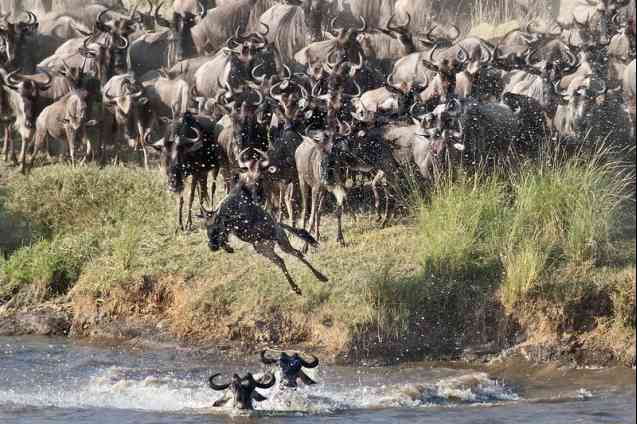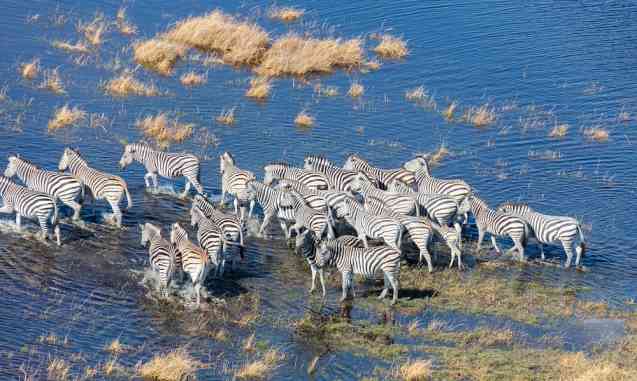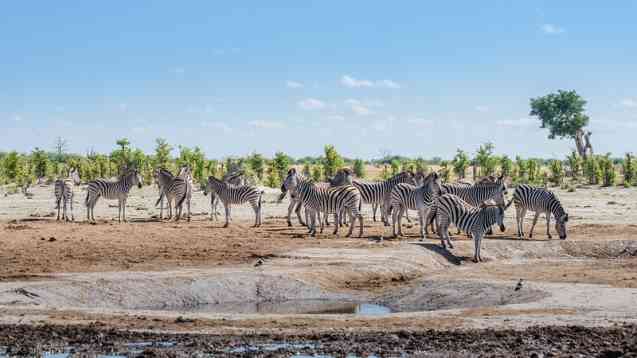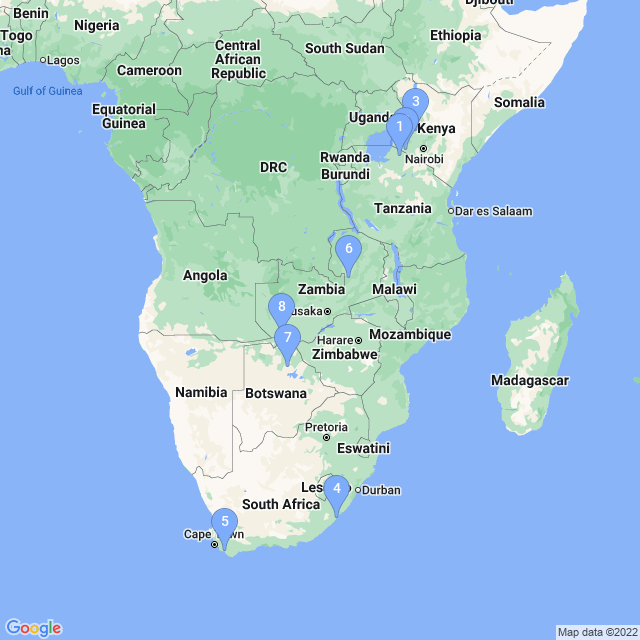The Biggest Animal Migrations in Africa: the Great Wildebeest Migration & More
Animal migrations in Africa are some of the most amazing animal events on the planet. Witnessing animals and their antics in the wild is always special. Witnessing wild animals migrating in their hundreds, thousands, or millions is both rare and unforgettable. From the stampeding herds of the great wildebeest migration in Kenya and Tanzania to flamboyant flocks of carmine bee-eaters gathering along the Zambezi in Namibia, you could even plan your year around African animal migrations!
This post covers all the greatest African animal migrations. From January through to December, we'll show you African migration animals, and tell you where and when to be to witness these African migration events.
Skip to the month-by-month calendar of major animal migrations in Africa
January to March – Great Wildebeest Migration: calving season in the Serengeti, Tanzania
The great wildebeest migration from the plains of the Serengeti in Tanzania to the Masai Mara in Kenya is arguably the greatest migration on earth. The scenes of over 1.5 million wildebeest, zebras, and antelopes, crossing the Serengeti plains, and braving the crocodile-infested Mara River, have been a mainstay of wildlife documentaries for decades. This is the biggest and most epic movement of African migration animals anywhere on the continent. The great wildebeest migration is at the top of most safari bucket lists.
 Serengeti wildebeest migration by flowcomm
Serengeti wildebeest migration by flowcomm
Contrary to popular belief, the great wildebeest migration is not a single event but rather the continuous movement of herds of animals over the entire year. Where rain falls, grass grows and the cycle of life and death follows in its wake. That being said, there are two flash points of the great migration worth planning your African migration safari around. The January and February calving season in the southern Serengeti and the crossing of the Mara River into Kenya and the Masai Mara National Reserve which we will cover later in the blog.
 Great migration in Tanzania by Tina Case
Great migration in Tanzania by Tina Case
In January and February every year, the great wildebeest migration begins in Tanzania’s southern Serengeti Park. These lush green plains in the Ndutu region of the Ngorongoro Conservation area become a safari enthusiast’s wildest dream as female wildebeests give birth to about 8,000 calves a day! There are two main drawcards here. Firstly, the chance to witness the birth of a new gnu is high. Secondly, you have a good chance of seeing some predator action. Savannah predators have a nose for vulnerable life and such a large aggregation of new life means a coming together of predators: lions, leopards, cheetahs, hyenas, and wild dogs. From start to finish about 250,000 wildebeest are lost to predation, river crossings, and fatigue during the great wildebeest migration.
 Wild dog hunting wildebeest calf in Serengeti by Per Harald Olsen
Wild dog hunting wildebeest calf in Serengeti by Per Harald Olsen
Witnessing this finely balanced survival act where calves must find their feet in minutes or risk being eaten, is the African wilderness at its miraculous and brutal best. From the end of March, the herds move gradually from the southeast to the southwestern Serengeti, sometimes in large groups and at other times splitting up. During this time, the herds are grazing and the calves are gaining strength ready for the northward push at the start of May.
Wildebeest Fact File |
|---|
|
April, May, and June – Flamingos in Kenya
The lakes of the Great Rift Valley in East Africa are a birdwatcher's paradise. Here, safaris will encounter an African animal migration of the avian kind. The lakes of the Great Rift Valley boast not only abundant wildlife but abundant bird life too. From raptors like eagles and vultures to sparrows, finches, kingfishers, storks, herons, ducks, and ostriches… birdlife in East Africa comes in an incredible variety of shapes and sizes. The toast of the avian world is the aggregation of flamingos on these lakes in Kenya, for possibly the most colourful African animal migration.
 Flock of flamingos in Kenya by Brad
Flock of flamingos in Kenya by Brad
The secret ingredient to this bright and colourful flamboyance is the food. Greater and lesser flamingos seasonally migrate between lakes in search of the best and most abundant food sources. Carotenoids - the same pigment that gives tomatoes and carrots their respective red and orange hues - turn flamingos coral orange and bright pink. The source of these carotenoids is the algae that thrive in the shallow waters of these alkaline soda lakes.
In years past, flamingos massed in Kenya’s Lake Nakuru but due to increased rains in the area, these patterns have shifted. The rains raised the levels of Lake Nakuru and the alkalinity decreased leading to a reduction of algae and so lessening of the flocks from over a million birds to mere thousands. The flamingos had to go somewhere else. So, they flocked to Lake Bogoria, roughly a 2.5-hour drive north of Lake Nakuru.
 Flamingo flocks by Uzi Yachin
Flamingo flocks by Uzi Yachin
Lake Bogoria is a place of wild beauty. Surrounded by mountains and flanked by bubbling geysers and hot springs, it has a mythical feel that is punctuated by the distinct lack of visitors. The regiments of flamingos feeding in the lake are the stars of the show. If witnessing this astounding African animal migration is on your bucket list, then Kenya’s Lake Bogoria is a must. Due to the lack of accommodation, Lake Bogoria is often added as a day trip from Lake Baringo, Lake Naivasha, or Lake Nakuru.
Flamingo Fact File |
|---|
|
May to July – Sardine Run in South Africa
The Sardine Run along the east coast of South Africa has been described as “the largest biomass migration on the planet”. Millions of these tiny shimmering fish move along the Eastern Cape coastline to the warmer waters of KwaZulu Natal’s South Coast.
 Sardine Run in South Africa by majiedqasem Sardine Run in South Africa by majiedqasem |
 Sardine Run, East Coast of South Africa by majiedqasem Sardine Run, East Coast of South Africa by majiedqasem |
African animal migrations of any kind are subject to seasonal fluctuations, and tracking tiny fish in the ocean is even more challenging. As a general rule the action moves from the south, Gqeberha (Port Elizabeth) and East London (early May to June) to Coffee Bay, Port St Johns, and Mboyti (June to July). Experts suggest that instead of chasing the sardine migration, book according to your dates and wait for the sardines to come to you.
So how do you witness this phenomenon? Just as with other migrations, there is a whole host of oceanic life that relies on the sardine migration for a good feed. Sea birds, game fish, sharks, dolphins, and even whales move in to take advantage of this abundant food source.
The highlight of the Sardine Run is witnessing the decimation of a bait ball. A bait ball is a glittering mass of sardines, separated from the main shoal, that moves in unison as if it were a single, fluid organism. These bait balls are targeted by predators. Dolphins blow bubbles to concentrate the fish, sharks attack from below, and when the bait ball nears the surface, cape gannets dive from above… eventually, the sardines are so tired and disoriented that they lose the energy to fight and the predators pick them off until only loose scales glitter in the water.
 Sardine Run, Wild Coast in South Africa by majiedqasem Sardine Run, Wild Coast in South Africa by majiedqasem |
 Sardine Run on Wild Coast, South Africa by majiedqasem Sardine Run on Wild Coast, South Africa by majiedqasem |
Needless to say, the best way to witness this epic animal migration in Africa, is to get on a boat, preferably with the option to be IN the water with an experienced guide. With so much predatory action, the sardine run is the perfect time to get out on the water!
Sardine Fact File |
|---|
|
July and August – Great Migration: wildebeest crossing the Mara River
The second flash point of Africa's Great Migration is the crossing of the Mara River. The wildebeest migration also crosses the Grumeti River in the northwest Serengeti around May/June but the river, being smaller and shallower, presents more crossing points to the herds resulting in less dramatic crossings.
 Great wildebeest migration, Africa by Lip Kee Yap
Great wildebeest migration, Africa by Lip Kee Yap
The Mara River presents the great wildebeest migration herds with arguably their most daunting challenge. Access to the river from precipitous banks, huge Nile crocodiles in the water, frenzied panicking herds, and predators lying in wait, are some of the dangers that lie in wait for the wildebeest and zebra attempting this river crossing. It is also an incredible opportunity for lucky safari enthusiasts to witness one of the greatest shows on earth.
 Great migration Mara River crossing by Richard Toller
Great migration Mara River crossing by Richard Toller
The great migration is the ultimate large animal migration in Africa - the zenith of safari drama. During the migration, 0.5% of the herd drowns in the Mara River. This leaves the equivalent of ten blue whales worth of biomass in the river ecosystem. The route of the great wildebeest migration follows a roughly circular movement through the Serengeti eco-system which spans both the Masai Mara in Kenya and the Serengeti in Tanzania:
 The great migration Africa map
The great migration Africa map
Find out more in The Great Migration Africa: answers to your wildebeest migration safari FAQs
August, September, and October – Whale Watching in Hermanus South Africa
Every year between the southern hemisphere’s winter and spring, Southern right whales migrate from the Antarctic waters to the sheltered shallows of the Western Cape. They have spent the winter months feeding and now move to the waters around Hermanus, Gansbaai and Cape Town to mate and calve. Hermanus in particular, offers fine wine and excellent food as an accompaniment to witness these giant African migration animals
 Southern right whale Hermanus, South Africa by Bernard Dupont
Southern right whale Hermanus, South Africa by Bernard Dupont
After a year-long gestation period, female Southern right whales give birth to a single calf. Between August and October, you can watch these oceanic behemoths and their 1-ton offspring navigating their first few months together. These gentle giants spend their days frolicking in the shallows, displaying flukes and flippers, and wowing crowds with occasional breaches.
 Southern right whale breaching in Hermanus, South Africa by Dan Mitler
Southern right whale breaching in Hermanus, South Africa by Dan Mitler
While an ocean safari is always worthwhile, Hermanus has arguably the best land-based whale watching in the world. Only a 90-minute drive from Cape Town, the entire town bustles with activity during the whale watching season (as the capital of the scenic Cape Whale Route). Hermanus even has a week-long eco-arts festival in September that attracts people from all over the world.
Southern Right Whale Fact File |
|---|
|
August to November – Carmine Bee-eater Migration in Namibia
The Carmine bee-eater is as distinctive as it is beautiful. Pink, rust and turquoise blue plumage make this bee-eater an African migration animal must-see. While the Carmine bee-eater spends the summer months in woodland savannah as far afield as South Africa, come August the birds begin to mass on the banks of the Zambezi River in northern Namibia.
 Carmine bee-eater migration, Namibia by P Burger
Carmine bee-eater migration, Namibia by P Burger
The Carmine bee-eater is monogamous. By late September, the birds have begun to pair off and breed. Courtship is complex with male birds offering ‘gifts’ of dead insects to woo their prospective mates as well as doing aerial combat to prove their fitness and agility. Bee-eaters make their nests at the end of long burrows in dry river banks. During excavation, large numbers of the birds remain on the ground and when threatened by predators like yellow-billed kites, take off on mass. Thousands of birds bursting into carmine flight is dizzyingly beautiful.
 Carmine bee-eaters, bird migration in Africa by Richard Toller
Carmine bee-eaters, bird migration in Africa by Richard Toller
By the end of November, these African migration birds have returned to their summer hunting grounds, leaving their nests to crumble until the following year. Witnessing these colourful birds in huge colonies in and about the Zambezi River banks is a must-see for twitchers and anyone who fancies witnessing an animal migration in Africa.
Carmine Bee-eater Fact File |
|---|
|
Late October to mid-December – Kasanka Bat Migration, Zambia
At only about 4,000ha²/400km², Kasanka National Park in northern Zambia is an unlikely destination for one of the biggest of Africa's animal migrations. Every year, towards the end of October, this tiny jewel attracts millions of African straw-coloured bats in an epic spectacle of mammalian flight.
 Fruit bats in Kasanka National Park, Zambia by Dante Aguiar
Fruit bats in Kasanka National Park, Zambia by Dante Aguiar
The African straw-coloured bats migrate from all over central Africa to feed on the fruiting trees of the evergreen swamp forest. By January all of the bats are gone. It is estimated that between 8 and 10 million bats descend on Kasanka, making this the largest mammal migration in the world. This particular African animal migration is responsible for up to 60% of forest seed dispersal, as well as flower pollination, making this event not only spectacular but also ecologically crucial.
Kasanka National Park has a few custom-built bat hides where there are two bat-specific viewing times. You can see the bats in the evening when they set out to feed and in the morning when they return to roost with up to twice their body weight full of fruit! It is quite something to listen to the sound of branches straining and cracking under the increasing burden of tired and stuffed bats!
Bat Fact File |
|---|
|
December to March – Zebra Migration in Botswana
The zebra migrations in Botswana are still a relatively new phenomenon to the safari fundi. This animal migration in Africa was undocumented up until 2004 when cattle fences (designed to limit the spread of bovine diseases) were removed. The removal of these fences saw the resumption of the zebra migration the second-largest land mammal migration in Africa. This African migration is broken into two distinct groups; the Nxai Pan zebra migration and the Okavango Delta to Makgadikgadi Pan movement.
 Zebra migration, Botswana Okavango Delta by Diego Delso
Zebra migration, Botswana Okavango Delta by Diego Delso
In November, after spending the summer months along the banks of the Chobe River, these migrating African animals in Chobe National Park begin to move south to the Nxai Pan National Park. It is a journey of about 250km and is triggered by the rains which fall on the Nxai Pan. These rains mean nutritious grazing, so the zebras migrate. They stay in the Nxai Pan Conservation area for about three months before heading north again to the Chobe River banks.
 Zebra migration Botswana by Michael Jansen
Zebra migration Botswana by Michael Jansen
The second group of zebra, this time accompanied by gnu, migrate for the same reason. These zebras spend the summer months around the Boteti River which flows south from the Okavango Delta. The same rains that trigger the migration of the Chobe zebra to the Nxai Pan trigger the Boteti group to move east towards the Makgadikgadi Salt Pans. Scientists are puzzled that only about 55% of the Boteti group migrate. The rest are permanent residents around the Boteti River.
To see this zebra migration, safari experts suggest that you concentrate your efforts on either the Nxai Pan or the Makgadikgadi Salt Pans to witness the abundant game, and bird life as well as all of the zebras.
Zebra Fact File |
|---|
|
Annual African Animal Migration Calendar (the Greatest Wildlife Migrations by Month)
NOTE: African animal migrations are wilderness events that come with an element of unpredictability. While animal migrations in Africa can be generally, and pretty accurately predicted, they are subject to environmental fluctuations. Rains fall earlier or later. There is less or more rain than expected. There are bumper years and years of drought. The animals are subject to their whims. This is meant as a ROUGH GUIDE to help plan your African migration animal safari adventure and to maximize your chances of seeing the wildlife events that you have always dreamed of.
January Safari:
- Start of wildebeest calving season, southern Serengeti, Tanzania
- Zebra migration, Nxai Pan and Makgadikgadi Pan, Botswana
February Safari:
- Wildebeest calving season, southern Serengeti, Tanzania
- Zebra migration, Nxai Pan and Makgadikgadi Pan, Botswana
March Safari:
- The tail end of wildebeest calving season, southern Serengeti, Tanzania
- Zebra migration, Nxai Pan and Makgadikgadi Pan, Botswana
April Safari:
- Flamingos on Lake Bogoria or Lake Nakuru, Kenya
- Zebras cross the Boteti River, Botswana
- Large concentration of zebra around Boteti River, Botswana
May Safari:
- Flamingos on Lake Bogoria or Lake Nakuru, Kenya
- Sardine run starts, in Gqeberha (Port Elizabeth) and East London, South Africa
June Safari:
- Flamingos on Lake Bogoria or Lake Nakuru, Kenya
- Sardine Run, Coffee Bay, Port St. John, or Mbogi, South Africa
July Safari:
- Wildebeest crossing the Mara River, Tanzania and Kenya
- Sardine Run, Durban and KwaZulu-Natal, South Africa
August Safari:
- Wildebeest crossing the Mara River, Tanzania and Kenya
- Carmine bee-eaters begin arriving on the banks of the Zambezi in Northern Namibia
- Start of whale season, Hermanus in South Africa
September Safari:
- High whale season, Hermanus South Africa
- In late September, Carmine bee-eaters begin breeding on the banks of the Zambezi, Northern Namibia
October Safari:
- Over 10 million bats arrive in Kasanka, Zambia
- In early October, Carmine bee-eaters begin breeding on the banks of the Zambezi, Northern Namibia
- End of whale season in Hermanus, South Africa
November Safari:
- Bats in Kasanka Park, Zambia
December Safari:
- Zebra mass to begin southern migration to South Nxai Pan from Chobe and East from Boteti River to the Makgadikgadi Pans, Botswana
 Zebra wildlife migration in Botswana
Zebra wildlife migration in Botswana
If you'd like to plan an African animal migration safari, contact an African safari expert for up-to-date information and trends.

__banner.jpg)
 On the outskirts of Marloth Nature Reserve, Andrew can be found walking and swimming in the beautiful Langeburg Mountains. He is passionate about animals, birds, reptiles, and plants and loves nothing more than an adventure in nature. An established artist with a master's in English literature, Andrew has traveled far and wide but South Africa still has his heart.
On the outskirts of Marloth Nature Reserve, Andrew can be found walking and swimming in the beautiful Langeburg Mountains. He is passionate about animals, birds, reptiles, and plants and loves nothing more than an adventure in nature. An established artist with a master's in English literature, Andrew has traveled far and wide but South Africa still has his heart.












